Abstract
One commonly used lubricant in rolling bearings is grease, which consists of base oil, thickener and small amounts of additives. Commercial greases are mostly produced from petrochemical base oil and thickener. Recently, the development of base oils from renewable resources have been significantly focused on in the lubricant industry. However, to produce an entirely bio-based grease, the thickener must also be produced from renewable materials. Therefore, this work presents the design and evaluation of three different bio-based polymer thickener systems. Tribological tests are performed to characterize lubrication properties of developed bio-based greases. The effect of thickener type on film thickness and friction behavior of the produced bio-based greases is evaluated on a ball-on-disc tribometer. Moreover, the results are compared to a commercial petrochemical grease chosen as benchmark.
1. Introduction
Lubricant industry develops and produces lubricating oils and greases for the lubrication of machine elements such as rolling bearings. Lubricants are essential to reduce friction and thus energy consumption on the one hand, and to prevent premature failure of machine elements due to wear. Lubricants also play an important role in damping the vibrations in bearings and decreasing the dissipated energy by decreasing the friction coefficient in the contact. Most lubricants available on the market today are still produced petrochemically, i.e., on the basis of fossil raw materials. With considering the expected shortage of fossil raw materials and the associated increase in the cost of products based on fossil raw materials, the industry is increasingly focusing on products made from renewable raw materials and the necessary adapted manufacturing processes [1,2]. Furthermore, in Germany, approximately 50% of the mineral oil-based lubricants used are released, each year, to the environment as a result of leakage or accidents, which causes environmental pollution due to chemical materials [3]. The first step toward developing biodegradable lubricants is to design sustainable lubricants, which are made of bio-based materials as an alternative to chemical resources [1].
Bio-based lubricants, such as ester or castor oil, are already available on market, which can be applied as an alternative to mineral oils [4]. In a recent study a bio lubricant is applied in a journal bearing and the friction behavior is compared to a mineral and a synthetic oil. It was found that, the bio lubricant showed lower friction compared to the mineral lubricant, however the synthetic oil showed the lowest friction [5]. In particular, there has been a focus on vegetable oils, such as palm oil and sunflower oil., to find a suitable bio-based lubricant. Vegetable oils in comparison with mineral oils are renewable, easy to obtain, environmentally friendly, economically cheaper and hence, sustainable [6]. There was also a suggestion for application of bio lubricants based on soybean oil improved by epoxy compounds, shown in [7].
Usually, a bearing grease is based on around 70 to 97% of base oil, up to 10% of additives and around 3 to 30 wt.% [8]. According to literature, it is accepted to call a material biogenic or bio-based if it is biodegradable or it is produced partly or completely from renewable raw materials, as defined in [9]. The thickener system can be either based on lithium soaps of fatty acids or petrochemical based oligomers or polymers such as polyureas. Although, bio-based lubricants can be an alternative to commercial petrochemical greases [10], they still need to be developed and a reliable application must be approved. Regarding data from Agency for Renewable Resources (Fachagentur Nachwachsende Rohstoffe e.V.-FNR) the available greases on market are maximum 85% bio-based, since the thickener system is normally not bio-based. To develop a full bio-based grease, base oil and thickener system must be made from renewable materials. Recently, there has been some works on the development of a complete bio-based greases. The results demonstrated in [11] reveal, that a cellulose pulp from the Eucalyptus Globulus plant was obtained as the raw material to produce a thickener system for a bio-based grease. The cellulose pulp was also optimized in another study as a suggestion for bio-based thickener production [12]. Moreover, in [13] it was shown that bio-based greases were developed based on castor oil and high-oleic sunflower oil with cellulose fibers as thickener. In other studies, friction coefficients of developed bio-based greases were comparable to the petrochemical greases [14,15,16]. Even the wear in bearing with application of bio-based greases were shown to be lower than petrochemical greases in [17]. Although, some bio-based greases have been proposed recently, it becomes more and more difficult to consider economic limits and ecological goals at the concurrently Therefore, new suggestions for bio-based greases are always needed [18]. An alternative for producing bio-based thickeners is to develop polymer-based thickeners, such as polyurea, from sustainable materials, due to their high abilities compared to raw materials. If the thickener system is a lithium soap of conventional high molecular weight fatty acids, it represents a bio-based thickener. The main differences between biogenically thickeners to non-biogenic thickeners is the origin of the raw materials.
Promising bio-based feedstocks for the production of lubricating greases include 1,5-pentamethylene diisocyanate (PDI) [19], 2,5-bisaminomethylenefuran (BAMF), 1,5-pentamethylene diamine (PDA) and 4,4′-diaminodiphenylmethane (MDA). PDA can already be obtained from glucose as reported in [20] and can be reacted with phosgene to give PDI. In this way, PDI with a biocarbon content of up to 70% can be obtained. BAMF can also be synthesized on the basis of glucose [21]. Hydroxymethylfurfural (5-HMF) is first obtained as the base chemical and converted to BAMF in several steps. At the present time, MDA cannot yet be produced bio-based on a large scale. However, MDA is produced on the basis of aniline, the sustainable production of which is already being worked on [22]. Thus, a substitution by bio-MDA is foreseeable in the near future.
Therefore, in this study we present the synthesis of bio-based polyurea thickener systems as well as the production method and chemical characterization of bio-based greases. Moreover, the focus of this study is to elucidate the tribological performance of the produced bio-based greases in comparison to a petrochemical reference grease. To evaluate the tribological performance, the results of film thickness and friction measurements on a ball on disc tribometer are discussed.
2. Lubricants and Methods
In the following the method of development and production of the bio-based greases are explained. Then to characterize the produced bio-based greases, methods of qualifications regarding tribological characteristics of the bio-based greases are explained.
2.1. Bio-Based Grease Development and Production
To produce the polyurea thickener systems, an in-situ polymerization of the monomers in castor oil was carried out. The reaction follows the mechanism of a polyaddition reaction. Three polyureas were prepared based on pentamethylene diisiocyanate (PDI) that was reacted with one of the diamines (a–c) (Scheme 1). As reaction vessel an ULTRA TURRAX® Tube Drive with ST-20 mixing vessel was used. The monomers were heated to melt and mixed in the oil at 100 °C. The PDI was added to the reaction mixture as the last component under stirring. After the addition of all components was completed, stirring was continued for another 2 min. A gel-like structure was typically formed within 10 s. The reaction progress was controlled by FTIR spectroscopy (Bruker Tensor 27, Berlin, Germany) shown in Figure 1. If the conversion was incomplete after two minutes and isocyanate bands were still detectable with the C-N band at 2270 cm−1, more stearyl amine was added to the reaction mixture until the C-N band completely disappeared. All three thickeners have a weight share of 15% of the grease. After cooling, the lubricating greases were homogenized by means of a three-roll mill.

Scheme 1.
Reaction scheme of polyurea grease production with all components.
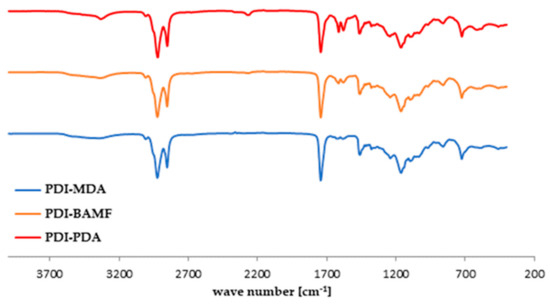
Figure 1.
IR-spectroscopy of all three bio-based greases. Bio-based grease 1: PDI-BAMF (orange), bio-based grease 2: PDI-PDA (red) and bio-based grease 3: PDI-MDA (blue).
For all three polyurea systems the same monomer ratio was chosen, i.e., diisocyanate:diamine:monoamine was 1:0.75:0.25. This results in a degree of polymerization of 9 for the chain length of the polymer thickeners. The theoretical chain length was calculated using the CAROTHERS equation [23].
The successful production of the desired polymeric thickener structures was verified by 1H-NMR spectroscopy (Bruker DPX-400, Berlin, Germany). First, the respective grease was extracted with ethyl acetate in a Soxhlet extractor for three hours. The solid residue was dried under reduced pressure and the thickeners were obtained as yellow powder. Since polyureas are nearly insoluble in organic solvents, the powder was dissolved in concentrated sulfuric acid (98%). To determine the chemical shift δ, a capillary with deuterium oxide phase-separated was used as reference in 1H-NMR spectroscopy.
Using the bio-based grease 1 (PDI-BAMF system) as an example, the analysis of the 1H-NMR spectrum is shown below. Using the 1H-NMR spectrum of the bio-based grease 1 thickener (Figure 2) the successful synthesis of the chemical structure can be confirmed. With 1H-NMR the real number of protons for a structure can be determined, if the amount for one signal is exactly known. As can be seen from Figure 2 with exception of the protons (5) between the urea group and the furan ring, all protons are visible in the spectrum. These protons are overlaid by the signal of the reference D2O. Since the FTIR spectra (Figure 1) showed that no C-N band is present anymore in the greases, a complete reaction with the termination reagent stearyl amine can be assumed. Thus, there are two alkyl end groups per polymer chain and the protons of the methyl end group (1) can be seen at 0.66 ppm. Since this signal is baseline separated it can be used as an internal reference for the integration of all signals of the spectrum and refers to six protons per polymer chain, due to the fact that each methyl end group has three protons. This makes it possible to determine the exact number of protons for the other signals in the spectrum. For this purpose, the integral of the methyl group protons (1) is set to six. The protons of the CH2 groups of the alkyl chains (4) in the immediate vicinity of the urea groups also give a baseline separated signal. Therefore, this integral allows an exact determination of the number of repeating units within the polymer chain. For the PDI-BAMF system, four protons must therefore be subtracted from the integral (4), since they belong to the end group. This results in 36 protons. Since there are four protons for (4) per repeat unit, this value is divided by four. This results in an average repeat unit of nine for the polymer chains of the PDI-BAMF thickener. The experimentally determined value of the mean repeating units were in good agreement with the previously calculated using the Carothers equation [23].
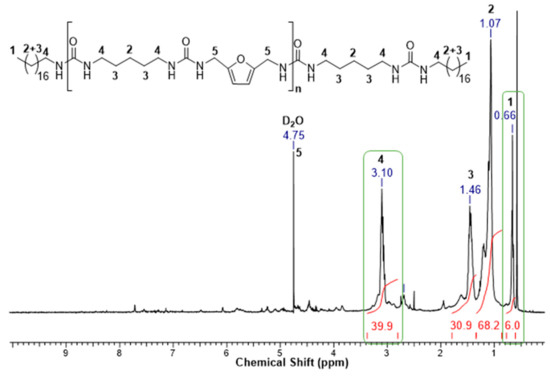
Figure 2.
1H-NMR spectrum of the PDI-BAMF thickener (bio-based grease 1).
Furthermore, the relative flow limit of the three lubricating grease systems was investigated by using an MCR 302 rheometer (Anton Paar, Ostfildern, Germany). Oscillation measurements according to DIN 51810-2 at 25 °C were performed. A plate-plate system with a geometry diameter of 25 mm was used. Forty-one data points were recorded for a shear deformation between 0.01 and 100%. The measurements were performed at a constant angular frequency of 1.59 Hz and a constant gap size of 1.000 mm. The flow limit was determined by the intersection of the logarithmically plotted curves from the storage and loss modulus. It was shown that castor oil is a suitable candidate regarding stability of produced grease and tribological characteristics such as friction coefficient [13,14,24]. Thus, castor oil was chosen as the base oil to produce the bio-based greases.
2.2. Qualification of Bio-Based Greases
The thickener systems and the stable bio-based greases were synthesized at TU Dortmund. The produced bio-based greases and grease properties are listed in Table 1. All bio-based greases had NLGI-class 2 as the result of investigations on penetration depth given in Table A3 in Appendix A. Furthermore, a petrochemical grease is also used for comparison the bio-based greases, which is also listed in Table 1.

Table 1.
Summary of the bio-based greases and tested lubricants. PAO = polyalphaolefine.
Tribological tests were performed at the Institute for Machine Elements and Systems Engineering (MSE) of RWTH Aachen University to characterize the greases. For this purpose, the film thickness in the EHD contact was measured on a steel ball-on-glass disc EHD2-Tribometer from PCS Instruments as shown in Figure 3. A polished steel ball with a diameter of 19.05 mm was pushed against a glass disc with 47 N. The resulting Hertzian pressure was aimed to be 700 MPa and the temperature during the measurements was set to 40 °C. The film thickness measurements were conducted based on the interferometry concept, which is described in [25]. This method of measurements was also used in the literature [26]. Film thickness measurements were performed under pure rolling conditions, where the sliding effects were not present in the contact.
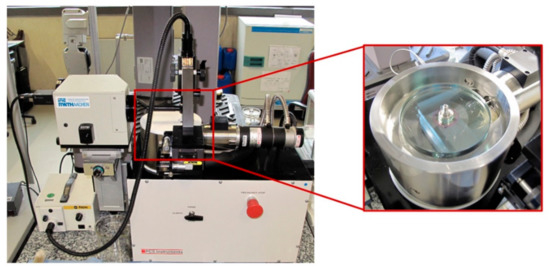
Figure 3.
EHD2-ball-disc tribometer of PCS Instruments.
As preparation for the film thickness measurements, the grease was distributed on the disc with a grease film height of approximately 0.1 mm using a grease distributer following the measurement procedure described in previous work by the authors [27]. Before the actual measurement, the grease was uniformly distributed on the rolling track in the contact area by applying a 15 min running-in phase at a constant rolling speed of 30 mm/s. During the film thickness measurement, the rolling speed was continuously increased from 4 mm/s to 1000 mm/s in approximately 45 min. For oils, the relation of film thickness over rolling speeds is known to be linear in double logarithmic diagrams [8]. Therefore, to compare the film thickness of greases over rolling speed to base oil, the film thickness was measured six times at 61 logarithmically distributed rolling speeds under pure rolling condition, i.e., slide-to-roll-ratio (SRR) of 0%.
As the next characterization method, developed bio-based greases were tested by mean of friction losses in the EHD contact. In order to do so, the friction measurements were conducted using the EHD2-ball-on-disc tribometer. In contrast to the film thickness measurements, the steel ball was pressed against a polished steel disc and a torque transducer measured the traction forces acting on the ball. The friction coefficients were calculated by dividing the traction forces by the normal forces given to the ball. The schematic representation of this procedure is shown in Figure 4.

Figure 4.
Schematic of the steel ball on steel disc friction measurements on EHD2 tribometer.
The material and roughness properties of the glass disc and steel disc and steel balls for measurements are listed in the Table 2.

Table 2.
Table of tribometer disc and ball material properties.
The lubricant conditions in the rolling contacts can be determined based on the definition of lambda ratio as in [29,30]:
where is the film thickness and is root-mean-square roughness of contact bodies.
According to [29,30], for values of higher than 3 for lambda, fluid regime and separation of both contact bodies is expected. Knowing the roughness of glass disc and steel ball from Table 2, corresponding film thickness value of lambda 3 was calculated equal to 18 nm. Analog to steel all and glass disc, corresponding film thickness of steel ball and steel disc can be calculated as 23 nm. The values show very small film thickness corresponding to lambda = 3. Therefore, it was assumed that no mixed lubrication regime occurs during the film thickness and friction measurements for the whole rolling speed range.
A relative speed between ball and disc was set to induce friction in the contact for friction measurements. Therefore, an SRR of 15% was adjusted. The greases are evenly distributed on the steel disc. Then, a running in phase was set before the actual friction measurement in analogy to the film thickness measurements. The EHD contact pressure for film thickness measurements was also 700 MPa and 40 °C. For each grease, both positive and negative SRR values were measured. This means that both scenarios of faster ball rotation than the disc and vice versa were measured. For each of the positive and negative SRR values, three independent measurements have been performed. In each test the rolling speed was increased from 15 mm/s to 1000 mm/s. The results were averaged to represent the trend of friction coefficient dependent on rolling speed.
3. Results and Discussion
In this section, three subsections are defined to demonstrate the results of characterization of bio-based greases. First, chemical characterization of the greases after production in labor is included. In the second subsection, results of film thickness measurements are explained. The three bio-based greases and the reference grease were compared and evaluated regarding the film formation capability and the occurrence of starvation. In the third subsection, the friction coefficients of the different greases were evaluated dependent on rolling speeds.
3.1. Chemical Characterisation
Through the knowledge of the exact chemical structure of the thickeners, it is possible to determine the proportion of bio-based carbons for all three thickener systems (Table 3). The castor oil used was completely bio-based and accounts for 85 weight percent of the total grease. The remaining 15 weight percent was thickener, as no additives were used. The PDI used has a bio-carbon content of 70%. The BAMF and PDA used were bio-based. Stearyl amine and MDA were used as petrochemical products. For the bio-based grease 1 thickener (PDI-BAMF), this resulted in a value of 64% bio-based carbon. Taking the weight percentages into account, the total value was 95% bio-based carbon. Similarly, for the bio-based grease 3 thickener (PDI-PDA), this resulted in a value of 62 percent bio-based carbon for the thickener and a total value of 94% bio-based carbon by weight for the system. For the bio-based grease 2 thickener (PDI-MDA), only 20% bio-based carbon was obtained for the thickener which results in 88% bio-based carbon by weight. In all three systems, the maximum proportion of bio-based carbon can thus be increased by at least 3%, and in the best case by as much as 10%, compared commercially available systems that are currently used.

Table 3.
Overview of all analytical data of the three thickener systems.
A flow limit of 16% was determined for the bio-based grease 1. Bio-based grease 3 had a flow limit of 25% shear deformation, which was the highest value of the three systems. Bio-based grease 2 showed the lowest value with a flow limit of only 5% (Figure 5). The flow limit of the bio-based greases can be correlated with the chemical structure of their thickeners. Both bio-based grease 1 and 2 contain aromatic thickener systems. The presence of aromatics in the polymer backbone results in a reduction of the chain mobility and stiffening of the polymer chain that may also facilitate π-π-stacking between different chains [31]. The chain stiffening increases even further for the PDI-MDA system, hence the lowest yield point is expected here. The bio-based grease 3 does not contain aromatics in the polymer backbone of the thickener and thus has the highest chain mobility. This allowed the system to withstand shear stress from the geometry for longer, resulting in a higher flow limit. The correlation of chain mobility as a function of polymer backbone has already been observed in rheology for other applications [32] and is in agreement with the literature.
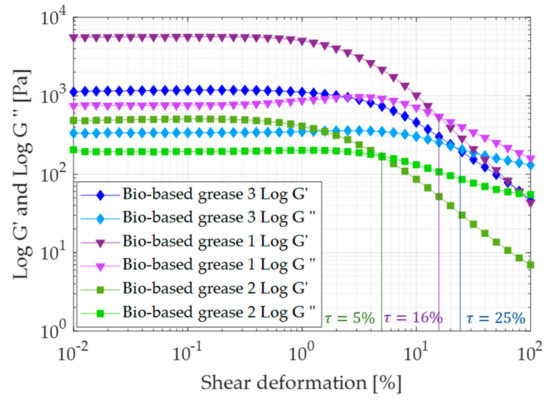
Figure 5.
Flow limit determination for bio-based grease 1 (purple), bio-based grease 2 (green) and bio-based grease 3 (blue).
Additionally, the dropping points of all systems were determined (Table 3). For the bio-based grease 1 a dropping point of 226 °C could be determined. The bio-based grease 3 had a dropping point of 252 °C. For the bio-based grease 2 a dropping point of 193 °C was determined. Class 2 was determined for the NLGI class of all three systems.
3.2. Film Thickness Measurements
In the first set of tribological characterization we measured the film thickness on ball-on-disc tribometer by varying the rolling speed to identify the onset of starvation for each grease. The results of film thickness measurements are shown in Figure 6.
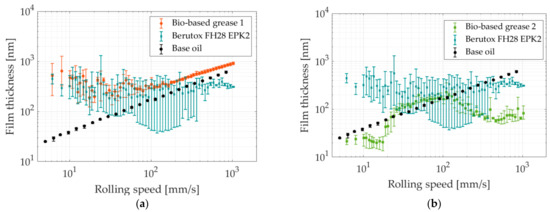
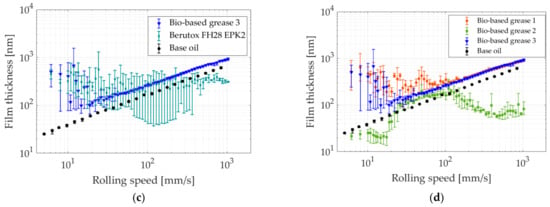
Figure 6.
Film thickness of bio-based greases over rolling speed compared to reference grease and base oil at hertzian contact pressure of 700 MPa at 40 °C with SRR = 0 on steel ball on glass disc tribometer: (a) film thickness of bio-based grease 1, reference grease and base oil over rolling speed; (b) film thickness of bio-based grease 2, reference grease and base oil over rolling speed; (c) film thickness of bio-based grease 3, reference grease and base oil over rolling speed; (d) film thickness of bio-based grease 1, 2 and 3 and base oil over rolling speed.
As a reference, film thickness measurement of castor base oil with a measured kinematic viscosity of 254 mm2/s at 40 °C is also shown. As stated before, three measurements were averaged to represent the trend of film thickness dependent on rolling speed. The aim of the development of bio-based greases was to identify the bio-based thickener and base oil combinations, which can be used in industry instead of potentially harmful petrochemical based greases and thus reduce harmful environmental influences. Therefore, a petrochemical reference grease was also used to carry out film thickness measurements in comparison to the bio-based greases.
As shown in the upper left diagram in Figure 6, up to the speed of 100 mm/s, film thickness of bio-based grease 1 was higher than base oil. This is caused by thickener effects, as already described in [33,34,35,36]. From a rolling speed of 100 mm/s, film thickness increases with further increasing rolling speed, similar to base oil behavior. This effect was the hydrodynamic film formation which mainly depends on the rolling speed and base oil viscosity. In the speed range between 100 mm/s to 1000 mm/s, the base oil dominates the film formation, and thickener effects, assumingly, play a minor role [37]. In slower speeds, up to 100 mm/s, it was shown that bio-based grease 1 had the same film thickness as the reference grease. From 100 mm/s, it was shown that the bio-based grease even higher film thickness than the reference grease, and with increasing the speed the film thickness difference also increases. The hydrodynamic behavior was not captured in reference grease. In upper right diagram in Figure 6, the film thickness of bio-based grease 2 was smaller than base oil curve up to 20 mm/s. The hydrodynamic behavior of bio-based grease 2 ranges from 20 mm/s to 150 mm/s. Above that speed, the film thickness decreases with increasing rolling speed. This may happen due to an insufficient amount of lubricant replenishment in contact [8]. As presented in lower left diagram in Figure 6, hydrodynamic behavior of bio-based grease 3 starts at 20 mm/s and no decrease below the base oil curve can be detected.
In the lower right diagram in Figure 6, three bio-based greases are compared. It can be seen that the bio-based grease 2 shows the smallest film thickness up to 70 mm/s among all bio-based greases. Probably, the effect of thickener in bio-based grease 2 was the least distinctive. Up to 70 mm/s, bio-based grease 1 shows around 100 to 300 nm higher film thickness compared to bio-based grease 3. Thus, bio-based greases 1 and 3 with thickener systems PDI-BAMF and PDI-PDA show a tendency to form higher separating films over the tested range of rolling speeds in comparison to bio-based grease 2 with thickener system PDI-MDA.
The results of the lubricant film thickness measurement also correlate with the chemical structure of the thickeners. As previously shown with the rheology measurements, the chain mobility also has a decisive influence on the formation of the lubricant film. The polymer chains of the PDI-MDA system (bio-based grease 2) have the highest chain stiffness, from which a small contribution of the thickener structure to the formation of the lubricating film can be deduced. The PDI-BAMF system (bio-based grease 1) also contains an aromatic structure, but has a higher chain mobility. The PDI-PDA system (bio-based grease 3) has the highest chain mobility and is, therefore, the most effective in film thickness formation.
3.3. Friction Measurements
The second method of characterization of the bio-based greases in this paper was measuring the produced friction coefficients on EHD contact on steel ball on steel disc measured by EHD2 tribometer by varying the rolling speed. Friction measurements were also conducted on the petrochemical reference grease to have a comparison with the bio-based greases.
The results of friction measurements are shown in Figure 7. In the upper left diagrams of Figure 7, it can be seen that friction coefficient in higher speeds, up to 800 mm/s, was same between bio-based grease 1 and the reference grease. The higher scatter in results was also observed in lower speed due to small grease particles passing through the contact, as was also captured in [38]. As shown in the upper right diagrams of Figure 7, the bio-based grease 2 shows similar friction coefficients to the reference grease up to 30 mm/s. In average speeds, from 30 mm/s to 400 mm/s, friction coefficient of the bio-based grease 1 was lower than the reference grease, and by higher speeds, from 30 mm/s, show both greases again the same friction coefficients. From the lower left diagrams of Figure 7, it can be seen that the friction coefficient of bio-based grease 3 is lower than the reference grease in all speed ranges up to 1000 mm/s. The friction coefficient of bio-based grease 3 decreases even further with increasing rolling speed.
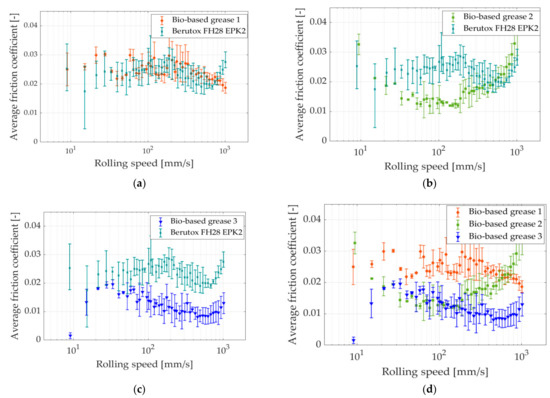
Figure 7.
Average friction coefficient of bio-based greases over rolling speed compared to reference grease at hertzian contact pressure of 700 MPa at 40 °C with SRR = 15% on steel ball on steel disc tribometer: (a) average friction coefficient of bio-based grease 1 and reference grease over rolling speed; (b) average friction coefficient of bio-based grease 2 and reference grease over rolling speed; (c) average friction coefficient of bio-based grease 3 and reference grease over rolling speed; (d) average friction coefficient of bio-based grease 1, 2 and 3 over rolling speed.
The bio-based greases are compared among each other in lower right diagram in Figure 7. It can be generalized that bio-based grease 3 results in the smallest friction coefficient. Up to 200 mm/s, bio-based grease 2 and 3 lead to similar values. The increase of friction at higher speeds for bio-based grease 3 can be linked directly to the decrease of film thickness and the occurring starvation at those speeds.
4. Conclusions
In this study, bio-based greases based on three bio-based polyurea thickener systems and bio-based castor base oil were developed and the tribological lubrication behavior of the greases was characterized on a ball-on-disc tribometer.
Results of film thickness and friction measurements of the bio-based greases as well as the corresponding pure castor base oil are compared among each other. The main results are summarized as follows:
- The bio-based grease 3 with PDI-PDA and bio-based grease 1 with PDI-BAMF system show comparable chemical and physical properties to known urea thickeners.
- The bio-based grease 2 with PDI-MDA system shows worse chemical and physical properties to known urea thickeners.
- The synthesized thickeners have a higher proportion of bio-based carbon and thus increase the total proportion of bio-based carbon to up to 95% for the whole grease.
- For small velocities up to 100 mm/s rolling speed, bio-based grease 1 shows better film forming behavior due to higher film thickness compared to the other developed greases. In higher speeds show bio-based grease 1 and 3 similar film thickness. The bio-based grease 2 shows smaller film thickness than 1 and 2 in thickener dominant area up to 70 mm/s and in higher speed ranges from 100 mm/s. Bio-based greases 1 and 3 are shown to have comparable to higher film thickness compared to the reference petrochemical grease.
- Friction coefficient of bio-based grease 3 is smaller in comparison to the other investigated greases. Thus, bio-based grease 3 induces less friction in the contact compared to other greases. Friction coefficient of developed bio-based grease 3 is shown to be lower than the comparable petrochemical reference grease.
- Since bio-grease 3 has advantageous film forming and friction behavior, the bio-based thickener type PDI-PDA in combination with castor oil seems to be most promising for full bio-based greases for an application in rolling contacts.
The developed bio-based polyurea greases show promising qualification results compared to reference petrochemical grease regarding film formation and friction coefficients. However, to have a complete bio-based grease, which can be used in industry, further qualification tests such as thermal stability of the greases and anti-wear properties of the greases must be performed. To investigate the anti-wear properties, experiments on bearing test rigs, as shown in [39], must be performed in future works. Furthermore, to develop a fully bio-based grease, production of the bio-based additives also should be focused.
Author Contributions
S.V., D.F. and M.J. wrote the article, designed and performed the experiments and analyzed the data. G.J., F.K. and R.W. supervised the work, discussed the basic design of experiments and provided suggestions for the final discussion. All authors have read and agreed to the published version of the manuscript.
Funding
This research was funded by Agency for Renewable Resources (Fachagentur Nachwachsende Rohstoffe e.V.-FNR) for the project “Entwicklung biobasierter Verdickersysteme zur Herstellung von Schmierfetten”.
Institutional Review Board Statement
Not applicable.
Informed Consent Statement
Not applicable.
Data Availability Statement
Supporting data for chemical formulations and characteristics of developed bio-based greases are included in Appendix A.
Acknowledgments
The authors would like to thank kindly all member of the project, Carl Bechem GmbH for supplying the reference grease and Covestro for supplying the PDI.
Conflicts of Interest
The authors declare no conflict of interest.
Appendix A
Castor oil from Carl Roth (Karlsruhe, Germany), 1,5-pentamethylene diisocyanate (PDI) from Covestro (Leverkusen, Germany), 4,4′-diaminodiphenylmethane (a) (MDA), 1,5-pentamethylene diamine (c) (PDA), stearyl amine from TCI (Zwijndrecht, Belgium) and 2,5-Bis(aminomethyl)furan (BAMF) from Carbosynth (Compton, UK) were used to produce the greases (Figure A1 and Figure A2).
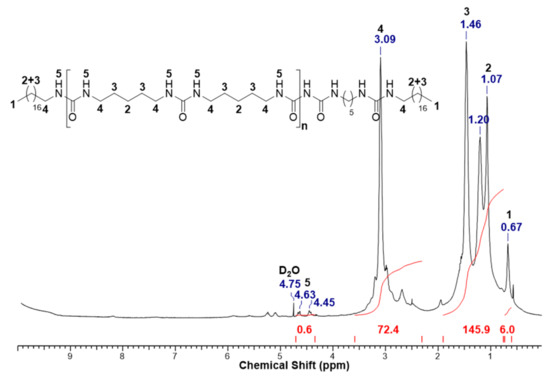
Figure A1.
1H-NMR spectrum of the PDI-PDA thickener.
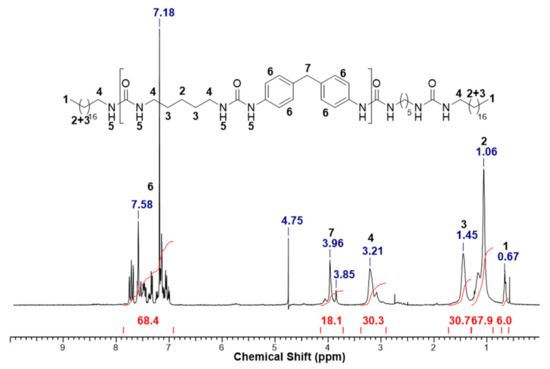
Figure A2.
1H-NMR spectrum of the PDI-MDA thickener.

Table A1.
Overview of all analytical data of the three thickener systems.
Table A1.
Overview of all analytical data of the three thickener systems.
| Thickener | PDI | Diamine | Stearylamine | Castor Oil |
|---|---|---|---|---|
| (a) PDI-BAMF | 483 mg, 1 eq. | 296 mg, 0.75 eq. | 211 mg, 0.25 eq. | 9590 mg |
| (b) PDI-MDA | 398 mg, 1 eq. | 384 mg, 0.75 eq. | 174 mg, 0.25 eq. | 9590 mg |
| (c) PDI-PDA | 520 mg, 1 eq. | 258 mg, 0.75 eq. | 227 mg, 0.25 eq. | 9590 mg |

Table A2.
NLGI-Class determination.
Table A2.
NLGI-Class determination.
| Bio-Based Grease | Penetration Depth [10−1 mm] | NLGI Class |
|---|---|---|
| (a) PDI-BAMF | 281 | 2 |
| (b) PDI-MDA | 294 | 2 |
| (c) PDI-PDA | 270 | 2 |

Table A3.
Thermal stability of the bio-based greases.
Table A3.
Thermal stability of the bio-based greases.
| Bio-Based Grease | Dropping Point [°C] | Tdegradation at 10% mass lost [°C] |
|---|---|---|
| (a) PDI-BAMF | 225.8 | 279 |
| (b) PDI-MDA | 192.8 | 281 |
| (c) PDI-PDA | 251.6 | 275 |
References
- Syahir, A.Z.; Zulkifli, N.W.M.; Masjuki, H.H.; Kalam, M.A.; Alabdulkarem, A.; Gulzar, M.; Khuong, L.S.; Harith, M.H. A review on bio-based lubricants and their applications. J. Clean. Prod. 2017, 168, 997–1016. [Google Scholar] [CrossRef]
- Jain, A.; Suhane, A. Capability of Biolubricants as Alternative Lubricant in Industrial and Maintenance Applications. Int. J. Curr. Eng. Technol. 2013, 3, 179–183. [Google Scholar]
- Bundesministerium für Verbraucherschutz, Ernäherung und Landwirtschaft. Bericht über Biologisch Schnell Abbaubare Schmierstoffe und Hydraulikflüssigkeiten; Bundesministerium für Verbraucherschutz: Berlin, Germany, 2002. [Google Scholar]
- Dwivedi, M.C.; Sapre, S. Total vegetable-oil based greases prepared from castor oil. J. Synth. Lubr. 2002, 19, 229–241. [Google Scholar] [CrossRef]
- Nikolakopoulos, P.; Bompos, D. Experimental Measurements of Journal Bearing Friction Using Mineral, Synthetic, and Bio-Based Lubricants. Lubricants 2015, 3, 155–163. [Google Scholar] [CrossRef] [Green Version]
- Panchal, T.; Chauhan, D.; Thomas, M.; Patel, J. Bio based grease A value added product from renewable resources. Ind. Crops Prod. 2015, 63, 48–52. [Google Scholar] [CrossRef]
- Adhvaryu, A.; Erhan, S.Z. Epoxidized soybean oil as a potential source of high-temperature lubricants. Ind. Crops Prod. 2002, 15, 247–254. [Google Scholar] [CrossRef]
- Lugt, P.M. Grease Lubrication in Rolling Bearings; John Wiley & Sons Ltd.: Oxford, UK, 2012; Chapter 9; pp. 213–226. [Google Scholar]
- European Commision. Bio-Based Products. Available online: https://ec.europa.eu/growth/sectors/biotechnology/bio-based-products_en (accessed on 9 August 2021).
- Reeves, C.J.; Siddaiah, A.; Menezes, P.L. A Review on the Science and Technology of Natural and Synthetic Biolubricants. J. Bio Tribo-Corros. 2017, 3, 1769. [Google Scholar] [CrossRef]
- Cortés-Triviño, E.; Valencia, C.; Delgado, M.A.; Franco, J.M. Thermo-rheological and tribological properties of novel bio-lubricating greases thickened with epoxidized lignocellulosic materials. J. Ind. Eng. Chem. 2019, 80, 626–632. [Google Scholar] [CrossRef]
- Martín Alfonso, J.E.; Yañez, R.; Valencia, C.; Franco, J.M.; Díaz, M.J. Optimization of the Methylation Conditions of Kraft Cellulose Pulp for Its Use As a Thickener Agent in Biodegradable Lubricating Greases. Ind. Eng. Chem. Res. 2009, 48, 6765–6771. [Google Scholar] [CrossRef]
- Acar, N.; Kuhn, E.; Franco, J. Tribological and Rheological Characterization of New Completely Biogenic Lubricating Greases: A Comparative Experimental Investigation. Lubricants 2018, 6, 45. [Google Scholar] [CrossRef] [Green Version]
- Sánchez, R.; Franco, J.M.; Kuhn, E.; Fiedler, M. Tribological characterization of green lubricating greases formulated with castor oil and different biogenic thickener agents: A comparative experimental study. Ind. Lubr. Tribol. 2011, 446–452. [Google Scholar] [CrossRef]
- Gallego, R.; Arteaga, J.F.; Valencia, C.; Díaz, M.J.; Franco, J.M. Gel-Like Dispersions of HMDI-Cross-Linked Lignocellulosic Materials in Castor Oil: Toward Completely Renewable Lubricating Grease Formulations. ACS Sustain. Chem. Eng. 2015, 3, 2130–2141. [Google Scholar] [CrossRef]
- Nagendramma, P.; Kumar, P. Eco-Friendly Multipurpose Lubricating Greases from Vegetable Residual Oils. Lubricants 2015, 3, 628–636. [Google Scholar] [CrossRef] [Green Version]
- Graça, B.M.; Campos, A.J.V.; Seabra, J.H.O. Taper roller bearings lubricated with bio-greases. Exp. Mech. 2009, 17, 117–128. [Google Scholar]
- Bartz, W.J. Lubricants and the environment. Tribol. Int. 1998, 31, 35–47. [Google Scholar] [CrossRef]
- Morales-Cerrada, R.; Tavernier, R.; Caillol, S. Fully Bio-Based Thermosetting Polyurethanes from Bio-Based Polyols and Isocyanates. Polymers 2021, 13, 1255–1275. [Google Scholar] [CrossRef]
- European Commission Directorate-General for Research and Innovation Directorate Bioeconomy. Bio-Based Products—From Idea to Market—“15 EU Success Stories”; European Commision: Brussels, Belgium, 2019. [Google Scholar]
- Pelckmans, M.; Renders, T.; Van de Vyver, S.; Sels, B.F. Bio-based amines through sustainable heterogeneous catalysis. Green Chem. 2017, 19, 5303–5331. [Google Scholar] [CrossRef]
- Covestro. Bio-Anilin Basis-Chemikalie aus Biomasse. Available online: https://www.covestro.com/de/sustainability/lighthouse-projects/bio-anilin (accessed on 3 May 2021).
- Carothers, W.H. Polymers and polyfunctionality. Trans. Faraday Soc. 1936, 32, 39. [Google Scholar] [CrossRef]
- El-Adly, R.A.; Bedier, A.H.; Modather, F.H. Jojoba and Castor Oils as Fluid of Biobased Greases: A Comparative Study. Al-Azhar Bull. Sci. 2012, 23, 29–44. [Google Scholar]
- Johnston, G.J.; Wayte, R.; Spikes, H.A. The measurement and study of very thin lubricant films in concentrated contacts. Tribol. Trans. 1991, 34, 187–194. [Google Scholar] [CrossRef]
- Chen, J.; Tanaka, H.; Sugimura, J. Experimental Study of Starvation and Flow Behavior in Grease-Lubricated EHD Contact. Tribol. Online 2015, 10, 48–55. [Google Scholar] [CrossRef] [Green Version]
- Fischer, D.; Jacobs, G.; Stratmann, A.; Burghardt, G. Effect of Base Oil Type in Grease Composition on the Lubricating Film Formation in EHD Contacts. Lubricants 2018, 6, 32. [Google Scholar] [CrossRef] [Green Version]
- Forschungsvereinigung Antriebstechnik e.V. Dünne Schmierfilme Untersuchung des Schmierfilmaufbaus und der Reibung bei Dünnen Schmierfilmen Mittels Interferometrie und FE8-Wälzlagerversuchen; IME RWTH Aachen University: Aachen, Germany, 2013. [Google Scholar]
- Wittel, H.; Jannasch, D.; Voßiek, J.; Spura, C. Roloff/Matek Maschinenelemente: Normung, Berechnung, Gestaltung, 23rd revised and expanded ed.; Springer: Wiesbaden, Germany, 2017. [Google Scholar]
- Czichos, H.; Habig, K.-H. Tribologie-Handbuch, 4th ed; Springer Fachmedien Wiesbaden: Wiesbaden, Germany, 2015; pp. 127–180. [Google Scholar]
- Wheeler, S.E.; Bloom, J.W.G. Toward a More Complete Understanding of Noncovalent Interactions Involving Aromatic Rings. J. Phys. Chem. A 2014, 118, 6133–6147. [Google Scholar] [CrossRef] [Green Version]
- Romo-Uribe, A. On the molecular orientation and viscoelastic behaviour of liquid crystalline polymers: The influence of macromolecular architecture. Proc. R. Soc. Lond. A 2001, 457, 207–229. [Google Scholar] [CrossRef]
- Wilson, A.R. The Relative Thickness of Grease and Oil Films in Rolling Bearings. Proc. Inst. Mech. Eng. 1979, 193, 185–192. [Google Scholar] [CrossRef]
- Cann, P.; Spikes, H. Film Thickness Measurments of Lubrication Greases under Normally Starved Conditions. NLGI Spokesm. 1992, 56, 21–27. [Google Scholar]
- Cann, P.M.E. Thin-film grease lubrication. Proc. Inst. Mech. Eng. Part J J. Eng. Tribol. 1999, 213, 405–416. [Google Scholar] [CrossRef]
- Cann, P.M. Grease lubrication of rolling element bearings—Role of the grease thickener. Lubr. Sci. 2007, 19, 183–196. [Google Scholar] [CrossRef]
- Morales-Espejel, G.E.; Lugt, P.M.; Pasaribu, H.R.; Cen, H. Film thickness in grease lubricated slow rotating rolling bearings. Tribol. Int. 2014, 74, 7–19. [Google Scholar] [CrossRef]
- Cyriac, F.; Lugt, P.M.; Bosman, R.; Padberg, C.J.; Venner, C.H. Effect of Thickener Particle Geometry and Concentration on the Grease EHL Film Thickness at Medium Speeds. Tribol. Lett. 2016, 61, 470. [Google Scholar] [CrossRef] [Green Version]
- Rosenkranz, L.; Richter, S.; Jacobs, G.; Mikitisin, A.; Mayer, J.; Stratmann, A.; König, F. Influence of temperature on wear performance of greases in rolling bearings. Ind. Lubr. Tribol. 2021. [Google Scholar] [CrossRef]
Publisher’s Note: MDPI stays neutral with regard to jurisdictional claims in published maps and institutional affiliations. |
© 2021 by the authors. Licensee MDPI, Basel, Switzerland. This article is an open access article distributed under the terms and conditions of the Creative Commons Attribution (CC BY) license (https://creativecommons.org/licenses/by/4.0/).